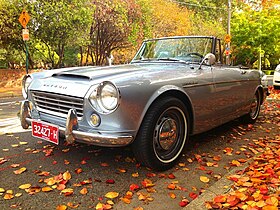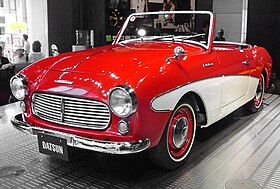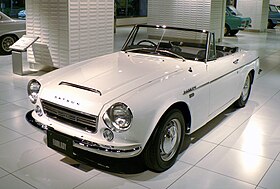Datsun Sports
| Datsun Fairlady/Sports | |
|---|---|
 Datsun Fairlady 1600 (in Australia) | |
| Overview | |
| Manufacturer | Nissan |
| Production | 1959–April 1970 circa 40,000 produced |
| Assembly | Yokohama Plant, Kanagawa-ku, Yokohama, Japan (Tonouchi Industrial, 1958-1960) Hiratsuka, Kanagawa (Nissan Shatai Plant, 1960-1970) |
| Designer | Yuichi Ōta |
| Body and chassis | |
| Class | Sports car |
| Body style | 2-door Roadster |
| Layout | FR layout |
| Chronology | |
| Predecessor | Datsun DC-3 |
| Successor | Nissan Z-car |
The Datsun Sports (called Datsun Fairlady in the Japanese and Australian markets), was a series of roadsters produced by Nissan in the 1960s. The series was a predecessor to the Z-car in the Fairlady line, and offered a competitor to the European MG, Triumph, Fiat and Alfa Romeo sports cars. The line began with the 1959 "S211" and continued through 1970 with the "SP311" and "SR311" line.
The Fairlady saw competitors follow its introduction, with examples called the Honda S500, the Toyota Sports 800, and the Daihatsu Compagno. In Japan, it represented one of three core products offered by Nissan at Japanese Nissan Dealerships called Nissan Shop, alongside the Datsun Truck and the Datsun 1000. The Datsun SRL 2000 was the 2 seat roadster that made their name. Paul Newman started his racing career in one. It had a potent 1982cc overhead cam engine with dual SU type side draft carbs and a 5 speed transmission. In 1991, Nissan introduced a limited number two-door convertible styled in a retro appearance to the Datsun Sports called the Nissan Figaro.
S211
| Sports 1000 S211 | |
|---|---|
 | |
| Overview | |
| Production | 1959–1960 20 produced |
| Designer | Yuichi Ohta |
| Body and chassis | |
| Related | Datsun Bluebird 211 Datsun Truck 220 |
| Powertrain | |
| Engine | 988 cc C I4 |
| Transmission | 4 speed manual |
| Dimensions | |
| Wheelbase | 2,220 mm (87.4 in) |
| Length | 3,895 mm (153.3 in) |
| Width | 1,455 mm (57.3 in) |
| Height | 1,350 mm (53.1 in) |
The first Datsun Sports model was the 1959 S211. It used a 988 cc C-series straight-4 producing 37 PS (27 kW; 36 hp). The S211 was based on the Datsun 211 sedan. Incorporated into the side trim were the side badges, which said "Datsun 1000". It was designed by Yuichi Ohta, who had previously designed the Datsun DC-3 and the prototype to the S211, the A80X.[1] Both the A80X and S211 featured fiberglass bodywork, influenced by the Chevrolet Corvette. Only 20 examples of the S211 were built, making the S211 the rarest of all Datsun models.

SPL212/SP213
| Fairlady / Sports 1200 SPL212 | |
|---|---|
 | |
| Overview | |
| Production | 1960–1961 288 produced |
| Body and chassis | |
| Related | Datsun 223 Pickup Datsun 1000 |
| Powertrain | |
| Engine | 1.2 L E I4 |
| Transmission | 4-speed manual |
| Dimensions | |
| Wheelbase | 2,220 mm (87.4 in) |
| Length | 4,025 mm (158.5 in) |
| Width | 1,475 mm (58.1 in) |
| Height | 1,380 mm (54.3 in) |
The SPL212 was introduced in 1960. This was the first Datsun sports car imported to the USA. The letter of "L" means "Left hand drive". Now with steel bodywork, it was built in slightly higher volume than the S211, with 288 produced through 1961. The SPL212 was based on the Datsun 223 truck. It had a 1.2 L (1189 cc) E-series straight-4 engine producing 48 PS (35 kW; 47 hp). A 4-speed manual transmission was specified, and an a-arm suspension with torsion bars was used in front. Drum brakes were used all around. This was the first vehicle to bear the "Fairlady" name. The badge on the trunk lid was the same badge that was used on the Datsun 223 truck. It was named in reference to the Broadway musical My Fair Lady.[2] The SPL212 and later SPL213 were sold only on the export market; they were named for their engine displacement. In 1960, production of the Fairlady was moved from Yokohama to the Nissan Shatai plant in Hiratsuka.
These cars are quite valuable. In 1996 a set of unrestored cars (SPL212) sold for US$100,000.
The SPL213, produced in 1961 and 1962, is very similar to the SPL212. The main difference is the dual-carburetor "E-1" engine which pumped out 60 PS (44 kW; 59 hp), a large increase in such a small and light car. Like the SPL212, the SPL213 was based on the Datsun 223 truck. 217 examples were built.
SP310/SPL310
| Fairlady/Sports 1500 SPL310/SP310 | |
|---|---|
 | |
| Overview | |
| Also called | Datsun 1500 |
| Production | August 1963–January 1965 |
| Body and chassis | |
| Body style | convertible |
| Related | Datsun Bluebird 310 Nissan Cedric 30 Datsun Truck 320 |
| Powertrain | |
| Engine | 1.5 L G15 I4 |
| Transmission | 4-speed manual |
| Dimensions | |
| Wheelbase | 2,280 mm (89.8 in) |
| Length | 3,953 mm (155.6 in) |
| Width | 1,495 mm (58.9 in) |
| Height | 1,275 mm (50.2 in) |
The first true Datsun sports car was the 1963 SP310 "Fairlady 1500" model (right hand drive), and the SPL310 (left hand drive). In America it was known as the Datsun 1500.[3] The SP310 was based on a modified Bluebird 310 sedan platform instead of the truck platform of earlier models. It featured an 85 hp 1.5 L (1,497 cc) G15 engine (from the Cedric) but with a single SU carburettor. Only 300 SPL310's were equipped with the single carb and these first few had only 77 HP as opposed to the 85 HP of the dual carb models built in 1964 and 1965. A four-speed manual transmission was the only shifting option and has a non-syncro'd first gear. The rear axle used the shafts and differential also from the Cedric. It was a well-equipped car with a transistor radio, tonneau cover, map lights, and a clock. The first SP310s (1963–1964) also had a unique sideways third seat in the rear.
Marketing
To coincide with the 1964 Summer Olympics, Nissan established the gallery on the second and third floors of the San-ai building, located in Ginza, Tokyo. To attract visitors, Nissan started using beautiful female showroom attendants where Nissan held a competition to choose five candidates as the first class of Nissan Miss Fairladys, modeled after "Datsun Demonstrators" from the 1930s who introduced cars. The Fairlady name was used as a link to the popular Broadway play of the era. Miss Fairladys became the marketers of Datsun Fair Lady 1500.[4][5][6]
SP311/SPL311
| Fairlady/Sports 1600 SPL311/SP311 | |
|---|---|
 Facelifted Datsun 1600 Roadster (1969) | |
| Overview | |
| Also called | Datsun 1600 |
| Production | January 1965–April 1970 |
| Body and chassis | |
| Body style | 2-door convertible |
| Related | Nissan Silvia CSP311 |
| Powertrain | |
| Engine | 1.6 L R16 I4[3] |
| Transmission | 4-speed synchromesh manual[3] |
| Dimensions | |
| Wheelbase | 2,280 mm (89.8 in) |
| Length | 3,955 mm (155.7 in) |
| Width | 1,495 mm (58.9 in) |
| Height | 1,300 mm (51.2 in) |
Many changes were made for 1965. Though the 1.5 L SP310 continued in production through January, a new 1.6 L R16-powered SP311 and SPL311 joined it. The new model was first shown at the 1964 Tokyo Motor Show, but did not enter production until March 1965. The restyling was executed in part by Count Albrecht Goertz, who would later be involved with designing the first Fairlady Z.[7] Marketed as the Fairlady 1600, or the Datsun Sports 1600 in many export markets including North America, it featured 14 inch wheels and minor exterior changes.[7] The front suspension was independent.[3] The engine produced 96 PS (71 kW; 95 hp). The hood badge said "DATSUN" in individual letters, the rear badge said "DATSUN 1600", and the side badges said "Fairlady" (Japanese market) or "DATSUN 1600" (export market). The SP311 continued in production through April 1970.
The first Nissan Silvia coupe shared the SP311's platform. The CSP311 Silvia had an R16 engine developing 96 hp and used a modified Fairlady chassis. The Silvia was the first car fitted with Nissan's new R engine. The R engine was a further development of the 1,488 cc G engine.
Early in 1968 the 1600, just as the bigger 2000, was updated to meet new safety legislation. Toggle switches, a padded dashboard and padded center of the steering wheel were new inside. The door handles were flush fit lifting units, while the windshield was taller with a top mounted internal rear view mirror.
SR311/SRL311
| Fairlady/Sports 2000 SRL311/SR311 | |
|---|---|
 | |
| Overview | |
| Also called | Datsun 2000 |
| Production | March 1967–April 1970 |
| Powertrain | |
| Engine | 2.0 L U20 I4 |
| Transmission | 5-speed manual |
| Dimensions | |
| Wheelbase | 2,280 mm (89.8 in) |
| Length | 3,955 mm (155.7 in) |
| Width | 1,495 mm (58.9 in) |
| Height | 1,325 mm (52.2 in) |
| Curb weight | 950 kg (2,094 lb) |
The introduction of the 1967 SR311 and SRL311 saw a major update. Produced from March 1967 – 1970, the SR311 used a 2.0 L (1,982 cc) U20 engine and offered a five-speed manual transmission, somewhat unexpected for a production car at the time. The first-year cars (known as "half year" cars) are sought as there were fewer than 1,000 produced which are unencumbered with the 1968 model year emissions and safety changes. The new SOHC engine produced 135 PS (99 kW; 133 hp). An optional Competition package included dual Mikuni/Solex carburetors; a special "B" model camshaft for 150 PS (110 kW; 150 hp); higher limit gauges; and a license plate surround. In Australia there were no emission restrictions and all 2.0 litre cars were fitted with the Competition package as standard.[8]
Due to the 2.0 litre engine, Japanese versions were regarded as expensive, specialized, sports cars due to the annual road tax obligation.
The Datsun 2000 was lauded as a bargain sports car. It was raced by John Morton, Bob Sharp and others. Its sticker price was lowest in its class, but it won its class in C Production (Mikuni-Solex carburetors) and D-Production (Hitachi-SU carburetors), in SCCA racing on a consistent basis even after production stopped. For the full story of Nissan's involvement in early SCCA racing, the teams, drivers and cars, visit the Datsun Roadster SCCA pages.
1968
For 1968, the entire line was updated with a new body featuring a taller integrated windshield with an integrated rear-view mirror, a padded dashboard with non-toggle switches, and lifting door handles. In the US the engines were also fitted with new emissions controls, and the lesser 1600 continued as a companion model through the end of production. Australia had no such emission controls.
References
- ^ "1957 Datsun A80X". Datsun.org. Retrieved 2011-11-03.
- ^ Long, Brian (2006), Datsun Fairlady Roadster to 280ZX: The Z-Car Story, Poundbury, Dorchester, UK: Veloce Publishing, p. 20, ISBN 978-1845840310
- ^ a b c d Willson, Quentin (1995). The Ultimate Classic Car Book. DK Publishing, Inc. ISBN 0-7894-0159-2.
- ^ Nissan recalls the birth of Miss Fairlady
- ^ Fair Lady: Nissan’s beautiful showroom models
- ^ The Birth of Miss Fairlady
- ^ a b James M. Flammang (1994). Standard Catalog of Imported Cars, 1946-1990. Iola, WI: Krause Publications, Inc. p. 164. ISBN 0-87341-158-7.
- ^ Brook, P, 2000 Banzai Productions
Sources
- James T Crow, ed. (1968). "Datsun 2000 Sports and Datsun Sports 1600". Road & Track Road Test Annual: 40–45.
{{cite journal}}:|author=has generic name (help) - Alexander Palevsky (1998). "All the Lust Without the Rust". Sports Car International. 14 (V): 57.
External links
- Nissan Heritage Collection FAIRLADY
- "Production Numbers". Datsun.org. Archived from the original on March 15, 2005. Retrieved March 28, 2005.
- "1967 Datsun 2000 FAQ". Datsun.org. Archived from the original on March 10, 2005. Retrieved March 28, 2005.
- "www.fairlady.org - Datsun Roadster US racing history". Fairlady.org. Retrieved January 15, 2007.
- "www.fairlady.org - Datsun Roadster prototypes". Fairlady.org. Retrieved January 15, 2007.
- "1960 Datsun Fairlady".
- http://www.earlydatsun.com/index.html
